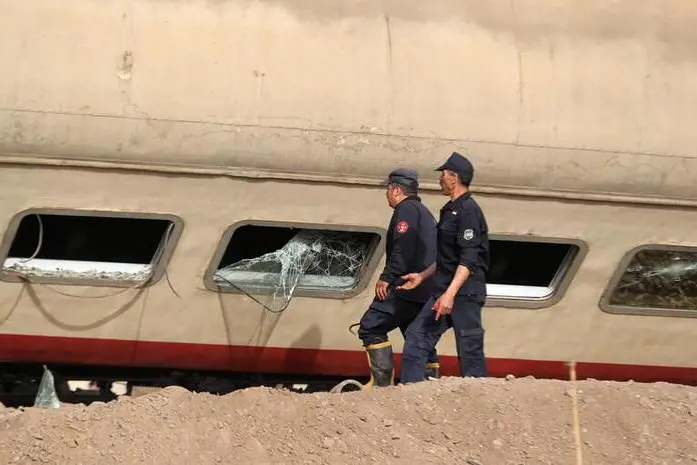PHOTO
Observers attributed the cause of the deadliest accident in Sohag to the confusion caused by decisions taken by the Egyptian Ministry of Transportation. In November, the minister in charge decided to solve the problem of train delays by disabling the electronic locking system that prevents collisions. This led to the Sohag disaster, according to observers. After the accident, Transport Minister Kamel Al-Wazir announced the return of the electronic locking system.
Regardless of the results of the investigations and the search for accountability for these accidents — as directed by President Abdel Fattah El-Sisi — the massive bleeding of lives due to accidents on Egypt’s railways must be stopped. This issue must be at the forefront of the state’s concerns, whether by ensuring accountability or proceeding with a complete overhaul of the system.
According to an official 2017 survey conducted by the Egyptian Railway Authority, in cooperation with the Central Agency for Public Mobilization and Statistics (CAPMAS), there were 12,236 train accidents in Egypt between 2006 and 2016. The deadliest occurred in 2002, when 361 people were killed after a crowded train burst into flames south of Cairo. In February 2019, the Ramses Railway Station in Cairo witnessed a terrible accident, when a speeding train hit a barrier at the edge of the platform, causing an explosion and a huge fire that killed 22 people. This accident caused the resignation of Transport Minister Hisham Arafat, who was succeeded by Al-Wazir, then the head of the Armed Forces Engineering Authority.
Under Al-Wazir, the Egyptian state undertook the task of modernizing the dilapidated railway system. Work has already started, leading to a decrease in the number of train crashes to 1,863 in 2019, compared to 2,044 in 2018 — a fall of 8.9 percent. As for 2020, the statistics of CAPMAS showed a 17 percent increase in train accidents, reaching a new high. However, a report by the government agency said the severity of accidents had decreased, despite the increase in their numbers. It said the number of victims decreased to only two in August 2020, compared to three during the same month the previous year.
Most of the train crashes that occur in Egypt are caused by human error, but the railway system is dilapidated and the current government and minister are bearing the burdens of the lack of investment over the past 20-plus years.
The Egyptian railway network is one of the oldest in the world. It includes the first railway line to be built in Africa and the Middle East, and the second in the world after the UK, completed in 1853. The Egyptian National Railways maintains a network of more than 5,000 km of track, primarily serving people on low incomes.
In the fiscal year 2019, the number of train passengers stood at about 270 million, compared to 228 million in 2015 and 247 million in 2010. The cost of operating the system ranges between 4 and 5 billion Egyptian pounds ($256 to $320 million), while revenues stand at about 2 billion Egyptian pounds.
Perhaps reforming this system was not in the minds of previous governments. A study by the Egyptian Initiative for Personal Rights, published in March 2019, confirmed that the frequent train accidents are due to the decline in spending on this service. This is despite the World Bank granting Egypt a $270 million loan to reform the railways in 2009. The value of the loan more than doubled in 2017, reaching $645 million.
The government has allocated 141 billion Egyptian pounds for spending on railway development until 2022 through a three-track plan. The first track covers building new railways, including an electrified railway and a monorail, as well as lines linking different parts of the country. The second track covers reforming the infrastructure, which includes the comprehensive renovation of stations, signaling systems, tracks and transfers, plus the establishment of electronic crossings. The third track covers the purchase of new locomotives and carriages.
The size of the reforms and their costs may delay some projects, especially since the government is still at the stage of talks regarding the financing of other projects it previously announced, which explains the continued occurrence of accidents due to past mistakes. However, what raises hope is that the Ministry of Transport, with the help of various state agencies, has already done a great job. It has completed the civil engineering works for 648 railway crossings out of the 1,101 scheduled to be completed under the plan, according to Al-Wazir. Work has also continued on developing and rehabilitating 262 railway stations, while Egypt has received batches of Russian Transmashholding trains as part of a deal that included 1,300 carriages, as well as locomotives from General Electric.
These efforts may stop the bleeding, which has forced the Egyptian government to accelerate the plan. But two important things remain: The first is the accountability that President El-Sisi emphasized in his commentary on the Sohag accident, and the second is the will to implement development regardless of the difficulties. This is the will that characterizes the current Egyptian government, provided that it is not at the expense of people’s lives.
- Dr. Abdellatif El-Menawy is a critically acclaimed multimedia journalist, writer and columnist who has covered war zones and conflicts worldwide. Twitter: @ALMenawy
Copyright: Arab News © 2021 All rights reserved. Provided by SyndiGate Media Inc. (Syndigate.info).












